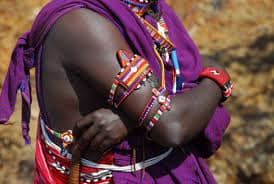The Masai people of East Africa are renowned for their vibrant cultural heritage, expressed through a myriad of traditional ornaments that adorn their bodies and symbolize their identity, status, and cultural significance. From intricate beadwork to elaborate jewelry, Masai ornaments hold a profound cultural and artistic value, reflecting the community’s history, beliefs, and way of life. This article delves into the diverse world of Masai ornaments, unraveling the symbolism, craftsmanship, and stories behind these treasured adornments.
Beadwork: A Tapestry of Colors and Symbols

Central to Masai ornamentation is beadwork, a time-honored craft passed down through generations. Beads hold deep symbolic meaning in Masai culture, with each color and pattern representing a specific aspect of life, such as courage, love, or unity. Masai women expertly weave intricate bead necklaces, bracelets, and earrings using a rainbow of colors, creating stunning pieces that not only beautify but also convey messages of identity, pride, and heritage.
Jewelry: Adornments of Status and Tradition
Beyond beadwork, Masai jewelry plays a significant role in cultural expression and social hierarchy. Elaborate brass, copper, and silver jewelry, often adorned with cowrie shells and colorful beads, are worn by both men and women during special occasions and ceremonies. Necklaces, bracelets, and anklets are not merely accessories but symbols of wealth, status, and spiritual protection, reflecting the wearer’s place within the community and their connection to the land.
Body Adornments: Embracing Tradition and Beauty

Masai body adornments go beyond jewelry and beadwork, encompassing a wide array of traditional accessories that embellish the body and enhance personal aesthetics. Leather belts, headdresses, and anklets intricately decorated with beads, shells, and feathers are worn by Masai men and women to celebrate cultural events, rites of passage, and everyday life. Each ornament carries a story, a memory, and a legacy of craftsmanship that speaks to the resilience and creativity of the Masai people.
Ceremonial Ornaments: Symbols of Ritual and Celebration
In Masai culture, ceremonies and rituals are integral to community life, marked by the wearing of specific ornaments that hold ritualistic significance. For example, the “sironka” headdress worn by Masai warriors symbolizes bravery and warriorhood, while the “olpayian” necklace worn by women signifies marital status and fertility. These ceremonial ornaments are not only decorative but also imbued with spiritual meaning, connecting the wearer to their ancestors, traditions, and the natural world.
Evolution of Masai Ornamentation: Balancing Tradition and Modernity
While Masai ornaments have deep roots in tradition and cultural heritage, they have also evolved over time to adapt to changing social dynamics and market demands. Today, Masai artisans blend traditional techniques with contemporary designs, incorporating new materials, styles, and motifs to appeal to a global audience while preserving the essence of Masai craftsmanship and symbolism. This fusion of tradition and modernity ensures that Masai ornaments continue to thrive as symbols of cultural pride, artistic expression, and community identity.

Conclusion: A Legacy of Beauty and Meaning
As we unravel the intricate world of Masai ornaments, we uncover a legacy of beauty, craftsmanship, and cultural significance that transcends time and borders. From the vibrant beadwork to the elaborate jewelry, each ornament tells a story of tradition, resilience, and creativity that defines the Masai people and their rich heritage. By adorning themselves in these treasured artifacts, the Masai celebrate their identity, honor their ancestors, and carry forward a legacy of artistry and symbolism that resonates with the world.




